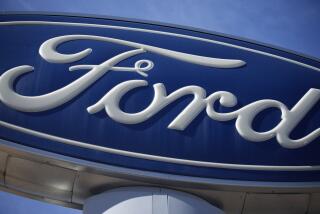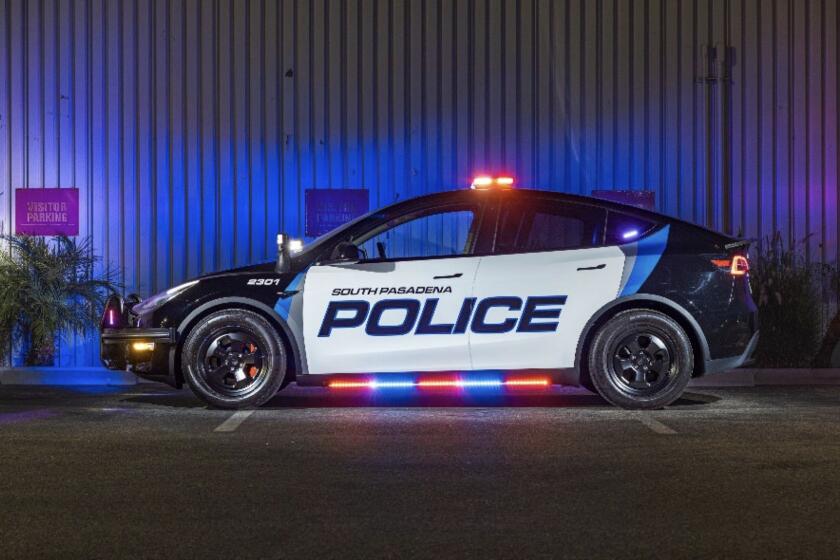2014 Detroit Auto Show: Honda unveils new-generation Fit
Honda Motor Co. hopes the redesigned Fit hatchback it introduced at the 2014 North American International Auto Show in Detroit will finally match the sales of more popular subcompact car rivals.
The Fit has been a sales conundrum for Honda. It gets rave reviews, yet its sales trail competitors by a significant margin. Honda sold about 52,000 Fits last year, while Nissan sold 117,000 Versas. Chevrolet, not known for its small cars, sold almost 86,000 Sonics while Ford sold more than 71,000 Fiestas.
That’s unusual for Honda, whose Accord, Civic and CR-V each crossed the 300,000 sales mark last year, making them among the bestselling cars nationally.
“Honda finds itself in an interesting position with the new Fit,” said Alec Gutierrez, an analyst at car price information company Kelley Blue Book. “At one time, that subcompact segment was owned by Honda with the Fit.”
A higher sticker price than its rivals is one of the problems Honda has wrestled with, said Jake Fisher, automotive test director for Consumer Reports.
The cost of the current Fit “is not that different from what you can get a small sedan for, and to a lot of people the sedan feels more substantial,” Fisher said. “Americans are hatchback adverse.”
PHOTOS: Highlights from the 2014 Detroit Auto Show
Honda hasn’t talked about the price of the new Fit, but does acknowledged that it has worked to lower its production expenses by shifting manufacturing of the model from high-cost Japan to a North American factory, an all-new plant in Celaya, Mexico.
That should ease the cost pressure. Expenses are lower in Mexico, and Honda won’t have to ship the cars across the Pacific Ocean, said Tetsuo Iwamura, chief executive of American Honda Motor Co., the company’s U.S. sales arm. Because the Fit will be made within the North American Free Trade Agreement boundaries, Honda will be relieved of a 2.5% import duty on the car, he said.
With the car selling in the budget segment, any expenses Honda can shave are important for both sales and profit, Iwamura said.
DETROIT AUTO SHOW: Big trucks, fast cars and more
This third-generation Fit will have a new platform — one that Honda will also use to build a tiny crossover — and a new engine. The direct-injected 1.5-liter four-banger will generate 130 horsepower and 114 pound-feet of torque.
It will come with a choice of a six-speed manual transmission or a continuously variable transmission, or CVT. Honda has moved to CVTs in the four-cylinder Accord and some Civic models to improve fuel economy. While other manufacturers have had problems with whiny CVT powertrains, Honda’s versions had received good reviews from automotive critics.
The Fit will be almost two inches shorter but slightly wider than the current model. The wheelbase is 1.2 inches longer, a configuration Honda said will provide improved handling and maneuverability.
A change in the location of the gas tank allowed Honda to increase the size of the cabin and provide more leg room to passengers in the rear seat.
The car will have EPA-estimated fuel economy ratings of 33 mpg for city driving, 41 on the highway and 36 combined.
Honda said one of its goals was to have the Fit top other subcompacts in safety ratings. That means extensive use of ultra-high-strength steel.
The automaker is still pondering future engine choices for the Fit. Honda already sells a hybrid version in Japan. It also has several other engines that might work with the car’s architecture, including a 1.0-liter turbocharged three-cylinder and a 2.0-liter turbocharged four-cylinder that can put out a whopping 280 horsepower.
No matter the improvements in both cost and the car, Honda has a challenge of selling small cars against changing demographics in the U.S. market, said Brian Johnson, an analyst with Barclays Capital.
“The average age of the car buyer is getting older,” Johnson said. “Younger consumers who would be the buyers appear to be less likely to buy cars than in the past, and that’s putting pressure on what already is a crowded small-car market.”
Stable gas prices also make it hard.
“The rush to the subcompact market has largely played itself out,” Gutierrez said. “Consumers are comfortable buying trucks and crossovers again.”
Moreover, the level of competition has increased, narrowing the gap between the Fit and its rivals, he said.
The Fit, which works best as a small car for driving in crowded cities, also faces competition from the cut-rate leases automakers are offering to get drivers into subcompact electric cars such as the Chevrolet Spark EV, the electric version of the Nissan Leaf and the electric Fiat 500.
“You also have a new bottom in the market, cars like the Mitsubishi Mirage, which you can get into for $12,000,” Gutierrez said. “The Fit is fighting a war on a number of fronts in a segment where growth is stagnant.”







